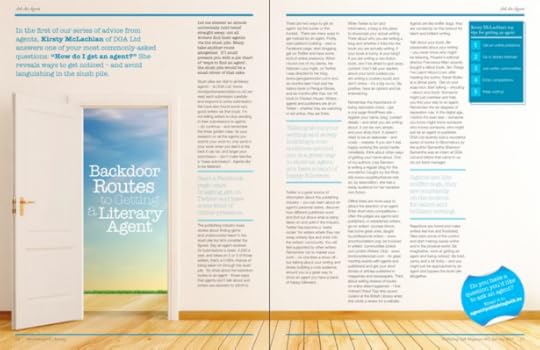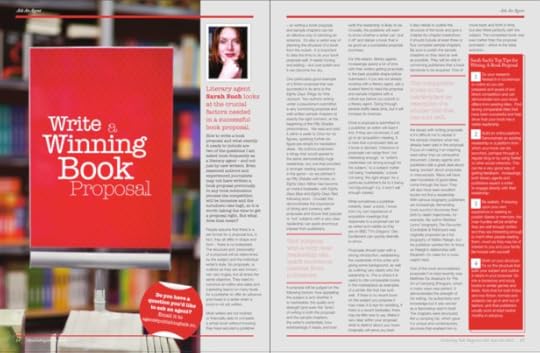Jon Reed's Blog, page 16
November 15, 2012
Publishing Talk Magazine 3, Nov-Dec 2012 – NaNoWriMo
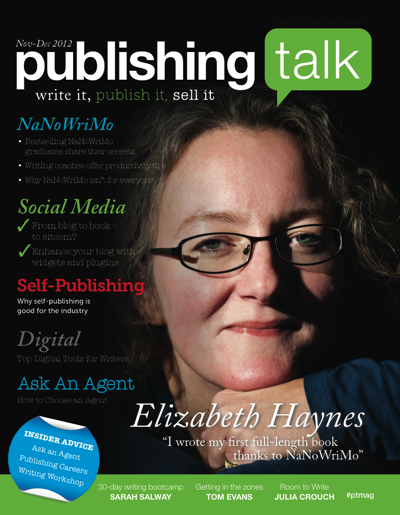 Can you write a novel in a month? NaNoWriMo graduates share their tips in issue 3 – available in print or digital.
Can you write a novel in a month? NaNoWriMo graduates share their tips in issue 3 – available in print or digital.
Whether you’re doing NaNoWriMo this year, saving your writing marathon for another month – or against the whole idea – there’s something for you in this issue.
We have two bestselling authors who used NaNoWriMo: Elizabeth Haynes and Julia Crouch; plus bestselling indie author Linda Gillard, who challenges the idea that churning out verbiage for an entire month has to be a good thing. Writing coaches Tom Evans and Sarah Salway are here to boost your productivity, Jon Reed looks at some digital tools to help you write, Suzanne Collier offers careers advice, and Kirsty McLachlan helps you decide which sort of agent is right for you.
On the social media front, we have Emily Benet’s Social Media Success Story, and there’s a step-by-step tutorial on adding widgets and plugins to your WordPress blog.
You might also like…
What we’re talking about in this issue
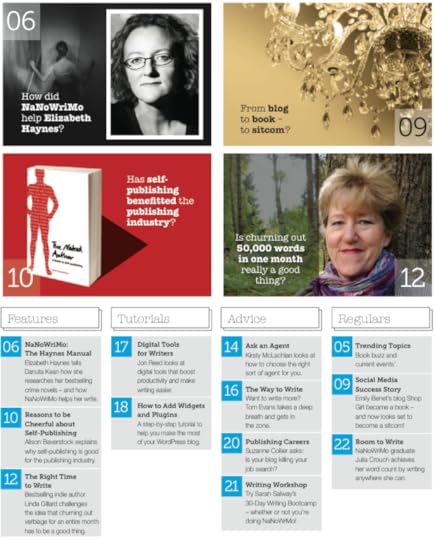
Buy now
 Publishing Talk Magazine is now available in three digital formats from this very website – PDF, mobi (Kindle) and ePUB – plus in print from MagCloud if you prefer. Or join the mailing list to get some free sample pages.
Publishing Talk Magazine is now available in three digital formats from this very website – PDF, mobi (Kindle) and ePUB – plus in print from MagCloud if you prefer. Or join the mailing list to get some free sample pages.
Issue 3 is available now:
 PLUS, for a limited time, you can buy DIGITAL editions of issues 1-4 for £7 – a saving of £5. That’s all four issues in three digital formats – 96pp, 56,000 words, 12 digital files and one single, easy payment.
PLUS, for a limited time, you can buy DIGITAL editions of issues 1-4 for £7 – a saving of £5. That’s all four issues in three digital formats – 96pp, 56,000 words, 12 digital files and one single, easy payment.
Publishing Talk Magazine is also available at Amazon.com and Amazon.co.uk.


Publishing Talk Magazine 03, Nov-Dec 2012 – NaNoWriMo
 PDF edition FREE to mailing list subscribers until 30 Nov 12!
PDF edition FREE to mailing list subscribers until 30 Nov 12!
November can mean only one thing: it’s NaNoWriMo time!
Whether you’re doing NaNoWriMo this year, saving your writing marathon for another month – or against the whole idea – there’s something for you in this issue.
We have two bestselling authors who used NaNoWriMo: Elizabeth Haynes and Julia Crouch; plus bestselling indie author Linda Gillard, who challenges the idea that churning out verbiage for an entire month has to be a good thing. Writing coaches Tom Evans and Sarah Salway are here to boost your productivity, and Jon Reed looks at some digital tools to help you write.
Issue#03 includes:
Elizabeth Haynes on how she researches her bestselling crime novels – and how NaNoWriMo helps her write
Emily Benet‘s social media success story – how her blog became a book, and now looks set to become a sitcom!
Alison Baverstock on why self-publishing has been good for the industry
Linda Gillard on why making your words count is more important than your word count
Kirsty McLachlan on how to choose the right type of agent for you
Tom Evans on unleashing creativity by getting ‘in the zone(s)’
Jon Reed on digital tools for writers
Step-by-step tutorial on adding widgets and plugins to your WordPress blog
Suzanne Collier‘s cautionary advice to job-seeking bloggers
Sarah Salway‘s 30-Day Writing Bootcamp
Julia Crouch on where she writes
Also available:
In print from MagCloud
As a Kindle from Amazon.com or Amazon.co.uk


#NaNoWriMo 30-day writing bootcamp (Week 3)
 Day 15: 7,500 words… and half way through so it’s time for a dance. Either you, or your character.
Day 15: 7,500 words… and half way through so it’s time for a dance. Either you, or your character.
Day 16: It’s midnight. Your character is awake. What’s going on?
Day 17: Write about the colour yellow.
Day 18: What music would your character listen to? Choose this in context of your novel – the place, the year, the age of your character. Keep playing this until it gets under your skin too.
Day 19: Write about the physical appearance of an object in great detail today. Really try to capture it on the page.
Day 20: You’ve reached at least 10,000 words … spend ten minutes writing down every nice thing other people have said about your writing – from your first teacher to your best friend. It doesn’t matter who, and don’t be modest. No one will see this but you.
Day 21: Your character makes a mistake.


November 7, 2012
#NaNoWriMo 30-day writing bootcamp (Week 2)
 Day 8: You’ll be sure of the names of your main characters by now. Look up the meaning ( is a good site, and has a fun random name generator to shake things up a little.) How can you include something from this in your section today?
Day 8: You’ll be sure of the names of your main characters by now. Look up the meaning ( is a good site, and has a fun random name generator to shake things up a little.) How can you include something from this in your section today?
Day 9: What’s the weather like? Too often we forget to add external details such as weather and season in our writing. How does this change the story?
Day 10: 5,000 words… and counting! Find a motivational quote about writing and stick it on your computer. One of my favourites is: “You fail only if you stop writing” – Ray Bradbury.
Day 11: What can your character smell?
Day 12: A letter comes…
Day 13: Interview your character: see www.sarahsalway.net/developing-characters
Day 14: If you’ve been writing in the same place every day, try something different. A new room in the house maybe, or a café. Take a bus and write on the top deck. Experiment.
Read Sarah’s full 30-day writing bootcamp in issue 3 of Publishing Talk Magazine, plus lots more advice, features and tutorials. Join the mailing list to get a free PDF copy as soon as it publishes!


November 1, 2012
Are you doing #NaNoWriMo? Here’s your 30-day writing bootcamp! (Week 1)
 So it’s November, that month when many writers start an annual obsession with word counts and sleep deprivation!
So it’s November, that month when many writers start an annual obsession with word counts and sleep deprivation!
So it’s November, that month when many writers start an annual obsession with word counts and sleep deprivation!
Yes, it’s NaNoWriMo time, when you are invited to write a 50,000-word novel over the course of just one month. Mad maybe, but you just have to look at the list of published novels resulting from this project – www.nanowrimo.org/en/publishedwrimos – to see there’s some magic going on.
It reminds me of a famous experiment outlined in the book Art and Fear, where a college professor divided a pottery class. Half had to produce just one perfect pot; the other half as many as they could. Surprise, surprise, the better pots were to be found in the second group – those who went for quantity over quality.
Because what this kind of pressure does is to release us from the perfection spell. Suddenly, it’s not our job to craft a beautiful melt-in-the-mouth sentence, but purely to get the words down. And once they’re down, of course, we can edit and make them better. Which as most writer will tell you is the fun bit, really, of the whole thing.
So even if you’re not doing the official NaNoWriMo, I invite you to create your own 30-day writing plan. The only rules are that you commit now to writing something EVERY DAY for the next thirty days, and that you don’t go back to edit or discard. Use these prompts below to keep you going. Some are for inspiration, some to motivate, some are to warm you up, and others you can just throw into your daily write to see what happens.
Day 1: You could spend this first day making word count charts, clearing your writing desk, compiling soundtracks for the novel, or agonizing over what your character really wants. But for today, just write. Five hundred words will do. And be like Hemingway, finish mid sentence. If your allotted five hundred words takes you exactly to the full stop, then start the next sentence: ‘And…’ Then stop.
Day 2: If 500 words works for you, stick to that. You might not have a novel at the end of the month, but you will have 15,000 words, which is more than you would have if you hadn’t started this. Otherwise ramp it up, but by no more than 2,000. The idea is to do some every day, not run out of steam after ten days. What you are going to do now might cause some of you extreme pain. I want you to download an internet-blocking programme such as Freedom – http://macfreedom.com – and give yourself fifty minutes of Internet-free writing time for each hour you work. You will have ten minutes between each hour to check emails, make coffee, complain… etc., but then it’s back to work for the next fifty minutes! This is called a ‘Power Hour’. Try it.
Day 3: From out of the window – write what your character sees?
Day 4: Today put your character somewhere uncomfortable. Get inside their skin. How do they feel?
Day 5: Congratulations! You’ve reached at least 2,500 words. As a treat, buy or find something small that your character would love. Put it in front of your computer so you can see it. What does your character like best about this thing?
Day 6: Make a list of your favourite words, cut them up and put them in an envelope. Pull one out when you are feeling as if you need some help and put it in your next sentence. This works best when you’ve no idea how to make it fit.
Day 7: There’s a knock at the door…
Read Sarah’s full 30-day writing bootcamp in issue 3 of Publishing Talk Magazine, which comes out next week. Or just stay tuned here for Part 2…


October 30, 2012
Emily Benet’s blog-to-book-to-sitcom success story
We’re all familiar with blog-to-book success stories. But what about blog-to-sitcom?
Regular readers will remember Emily Benet. She won the 2010 Author Blog Awards in the Published Author category, which was announced at the Publishing Talk tweetup at the London Book Fair. Her début book, Shop Girl Diaries, began as a weekly blog about working in her mum’s unusual chandelier shop. And this evening the Shopgirl Blog sitcom taster premières in London!
 Emily tells Publishing Talk: “I was very impatient to get my writing career off the ground. I wanted to write and I wanted people to read what I wrote, but I didn’t want to spend my life waiting for publishers to decide my fate. That’s why I began a blog, because I could bypass the editors and publish whatever I wanted.”
Emily tells Publishing Talk: “I was very impatient to get my writing career off the ground. I wanted to write and I wanted people to read what I wrote, but I didn’t want to spend my life waiting for publishers to decide my fate. That’s why I began a blog, because I could bypass the editors and publish whatever I wanted.”
Blogging has been hugely successful for her. Interest in her blog from Salt Publishing led to the publication of the book in December 2009. We hear a lot about the blog-to-book model – but Emily on the way to a further stage: blog-to-sitcom! The blog also attracted the attention of television director Chloe Thomas, leading to the shooting of the Shopgirl Blog taster for a sitcom, starring Katy Wix (Not Going Out) and Blake Harrison (The Inbetweeners).
There’s no point having a blog if you’re going to keep it a secret
Promoting her blog was key to her success. Emily says she “had a small following but that grew as I took my brother’s advice to spread the word online. There’s no point having a blog if you’re going to keep it a secret.”
The UK première of the short film is in London this evening. Sadly I can’t make it – but fortunately we can all enjoy it on YouTube. And aspire to our own blogs becoming books – and possibly sitcoms – one day!
 Shop Girl Diaries is available from Amazon.co.uk or Amazon.com. Emily is currently writing a serialized novel on wattpad called Spray Painted Bananas while editing her latest novel – a love story set in Barcelona during one summer of protests.
Shop Girl Diaries is available from Amazon.co.uk or Amazon.com. Emily is currently writing a serialized novel on wattpad called Spray Painted Bananas while editing her latest novel – a love story set in Barcelona during one summer of protests.
Look out for more of Emily’s social media success story, plus her top blogging tips in the forthcoming edition of Publishing Talk Magazine (issue 3, Nov-Dec 2012).


October 16, 2012
10 Tips for Giving a Talk in Public
This article first appeared in Publishing Talk Magazine issue 01 (Jul-Aug 2012).
Most of us have to do some public speaking at some point in our careers – whether as publishers or authors. Suzanne Collier offers her top tips.
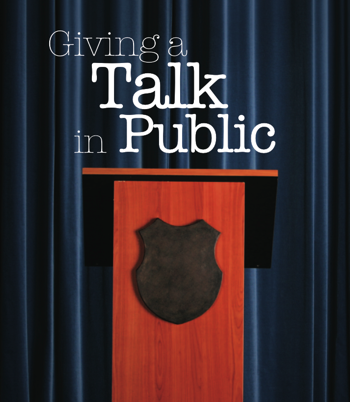
Hi Suzanne,
I’ve been given a new role at work and part of my new job involves public speaking and giving talks. I’ve never had to do this before and am very nervous. Do you have any tips you can pass on?
Mary
Hi Mary,
I’m required to do public speaking all the time, to audiences ranging from 30 to 200 and I do other coaching (presentations, interviews). Here are some of my golden rules:
1. RELAX. 99% of the time the audience is on your side, they want to hear what you are going to say.
2. SMILE. This relaxes you. My first card of prompt notes for any presentation always has a smiley face on, with the word ‘smile’. Usually as soon as I see this card I smile. This helps relax you and the audience – as they see you smiling. If you are in a situation where it is inappropriate to do, such as relaying bad news, then take a deep breath in and breath out, holding your posture upright. This breath should also have a calming effect.
3. PREPARE. Know what it is you are going to say. It is recommended not to cover more than three points in a talk, but you can do more than this if you can engage the audience, rehearse your talk many times, record and playback your speech. Listen to the points where your voice sounds uncertain or your voice dips and give some extra rehearsal time to those places. If you are getting bored during playback, so is your audience.
4. INVOLVE. Aim to involve the audience in your talk. Make statements that they can agree with or ask questions of them from time to time and wait for responses. Look around the room and watch them nodding in agreement or listen briefly to what the response is before you continue. Try to be inclusive as possible.
5. SPEAK SLOWLY. When speaking in public you need to speak slightly slower than normal speech. Don’t rush your talk. Pause from time to time. When you playback see how many times you say ‘ermm ermmm ermmm uhhhh’. Silence is much better than saying this. Don’t be afraid of silence. Silence is golden.
6. NOTES. Never read directly from notes but use cards as a prompt if your mind goes blank. This is why you need to rehearse. Practice makes perfect.
7. BREATHE. Remember to breathe. This will help calm you if you feel nervous. Keep your smiley/breathe card in vision. This will remind you to smile and relax.
8. POWERPOINT. If you are using PowerPoint don’t make your slides full of text, have some visuals that you have to explain. Also if you are going to make the slides available to everyone, say this right at the beginning and then people can sit and listen instead of taking copious notes. Always have a back up plan in case the power fails and you are talking without slides.
9. EYE CONTACT. If you are uncomfortable making eye contact, then look at people’s ears. Move your gaze around the room, address the right, the left, the centre, the front and the back; make everyone in the audience feel you are talking to them, and not just the back of the room.
10. YOU. Use the word ‘you’ instead of the word ‘I’; make the audience feel engaged.
Finally, ENJOY IT! Giving a talk in public is not like reading out your story in front of the class: in the majority of cases the audience has chosen to hear you speak. After your first public speaking experience you’ll wonder what all the fear was about.
Good luck! If you are still struggling and would like some personal coaching help on this, then get in touch.
Best wishes,
Suzanne
@SuzanneCollier @bookcareers
Do you have a publishing careers question you’d like Suzanne to advise on? Let us know in the comments, or use our Contact Form.


September 26, 2012
Backdoor Routes to Getting a Literary Agent
Let me shatter an almost universally held belief straight away: not all writers find their agents via the slush pile. Many take another route altogether. If I could present you with a pie chart of ‘ways to find an agent’, the slush pile would be a small sliver of that cake.
Slush piles are vital to all literary agents – at DGA Ltd we read each submission carefully and respond to every submission. We have also found some very good writers via that route. I’m not telling writers to stop sending in their submissions to agents – do continue – and remember the three golden rules: do your research on all the agents you submit your work to; only send in your work when you feel it is the very best it can be; and target your submission – don’t make it feel like a ‘mass submission’. Agents like to be flattered.
The publishing industry loves stories about finding gems and undiscovered talent in the slush pile but let’s consider the figures – say an agent receives 50 submissions a week, 2500 a year, and takes on 2 or 3 of those writers, that’s a 0.08% chance of being taken on through the slush pile. So what about the backdoor routes to an agent – those ways that agents don’t talk about and writers are reluctant to admit to.
…
Continue reading in issue 01 of Publishing Talk Magazine.


September 20, 2012
The Big Online Rip-Off
By Danuta Kean at alcs.co.uk:
In the face of the burgeoning power and influence of internet venture capital, and illegal filesharing sites, Danuta Kean rallies writers to bring their fighting skills up to date.
You have to hand it to the editors of Wikipedia – half of whom are under 28 – youthful rebellion never looked like this. By instigating a 24-hour blackout of the service in January, they became the first generation in history whose rebellion left corporations and venture capitalists clapping their hands in glee.
Glee, because the protest made it harder for democratically elected governments to pass legislation strong enough to protect ripped-off writers, musicians and other artists from those who profit from stolen intellectual property. Why? Because the blackout, which shut down the online encyclopaedia, was in protest against two bills before the US Congress: Stop Online Piracy Act (SOPA) and Protect IP Act (PIPA). The publicity it generated shook politicians so hard they quietly dropped the proposed legislation.
And that sets a disturbing precedent for any government that acts against online piracy. Because it shows the enormous power wielded by the 1,800 editors consulted about the blackout, even though not all of them are based in the USA. These editors have effectively mobilised a mass protest and media coverage (an estimated 115,000 websites supported the protest) that made politicians look like advocates for internet censorship.
…
Contrary to popular belief, illegal filesharing sites are not shoestring operations run by penniless kids. They require vast servers to host stolen content. They also require huge bandwidth to handle the illegal downloads. Even start-ups – let’s call them small town dealers – need computer equipment, software and broadband services that cost considerable amounts of money. To pay for their operations, traffickers use two revenue models: paid-for premium subscriptions that enable faster downloading; and display advertising – often supplied through Google Ads – which appears as content downloads.
Continue reading at alcs.co.uk.


September 19, 2012
How to Write a Winning Book Proposal
How to write a book proposal and what exactly it needs to include are two of the questions I am asked most frequently as a literary agent – and not just by new writers. Even seasoned authors and experienced journalists may not have written a book proposal previously. In any book submission process the competition will be immense and the turndown rate high, so it is worth taking the time to get a proposal right. But what does that mean?
People assume that there is a set format for a proposal but, in fact, they all differ in shape and form – there is no boilerplate. The structure and ‘personality’ of a proposal will be determined by the subject and the individual writer’s style. So proposals, or outlines as they are also known, can vary hugely, but all share the same objective. They need to convince an editor and sales and marketing teams on many levels for a publisher to offer an advance and invest in a writer when a book is not yet written.
Most writers are not inclined or financially able to complete a whole book without knowing they have secured a publisher – so writing a book proposal and sample chapters can be an effective way of clinching an advance. It’s also a useful way of planning the structure of a book from the outset. It is important to take the time to do your book proposal well. It needs honing and editing – but over-polish and it can become too dry.
…
Continue reading in Publishing Talk Magazine issue 02 – free this week!















